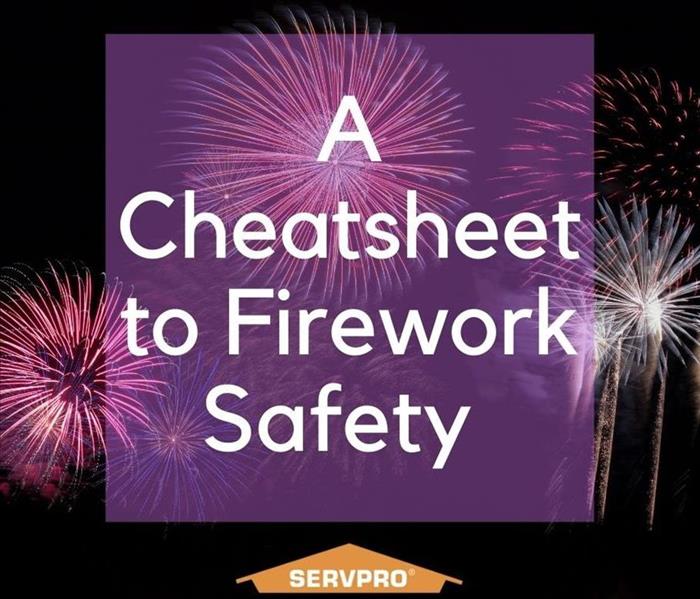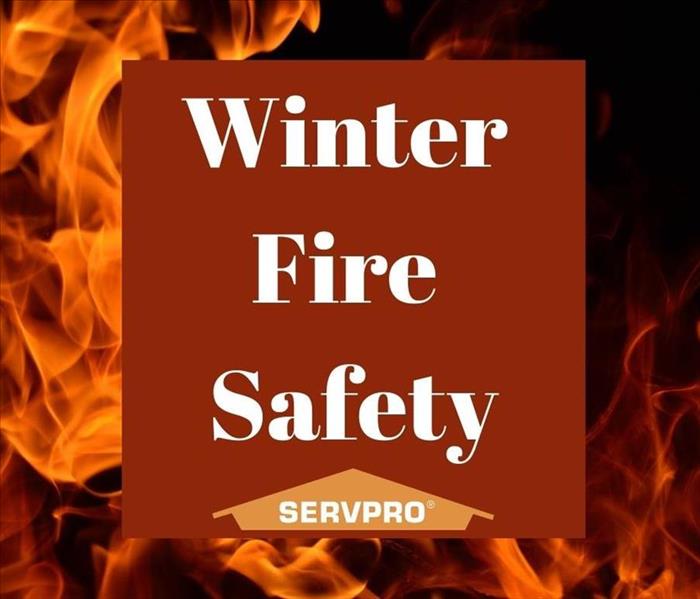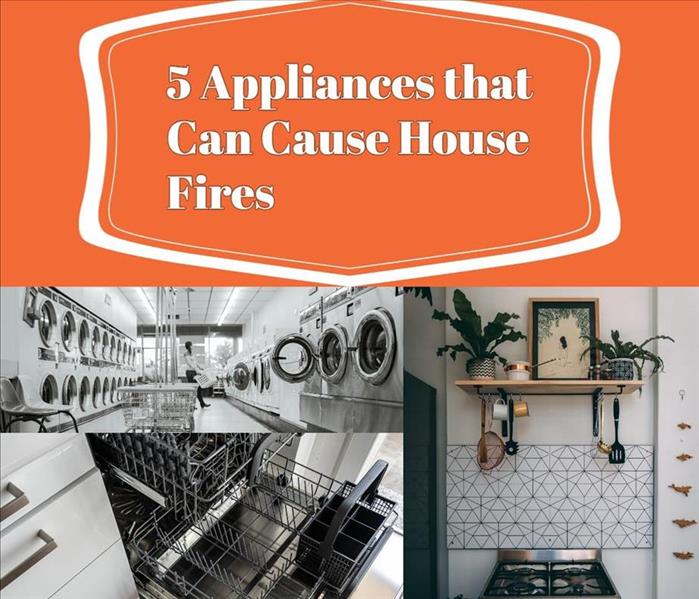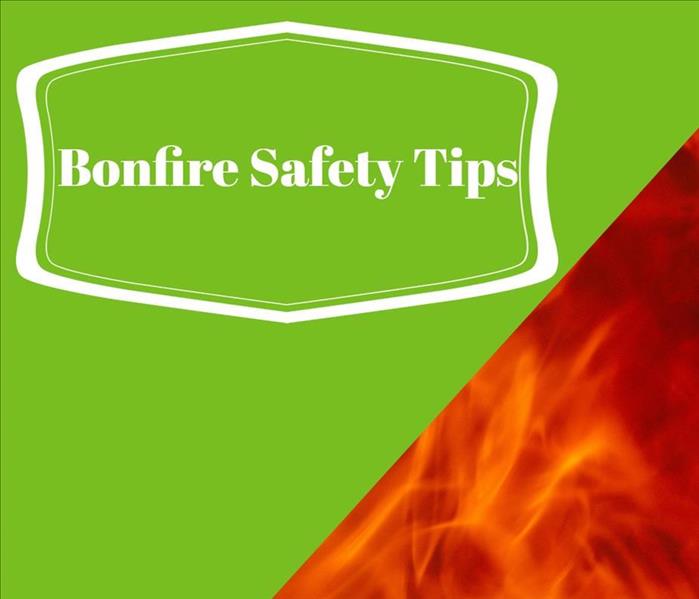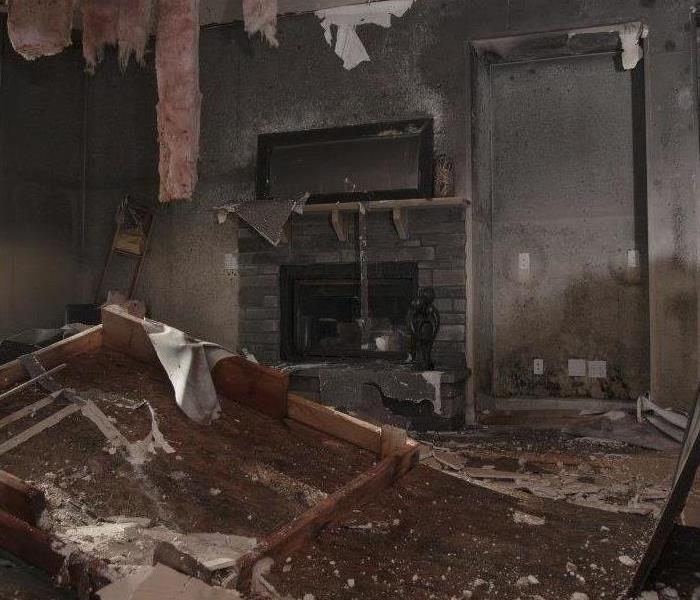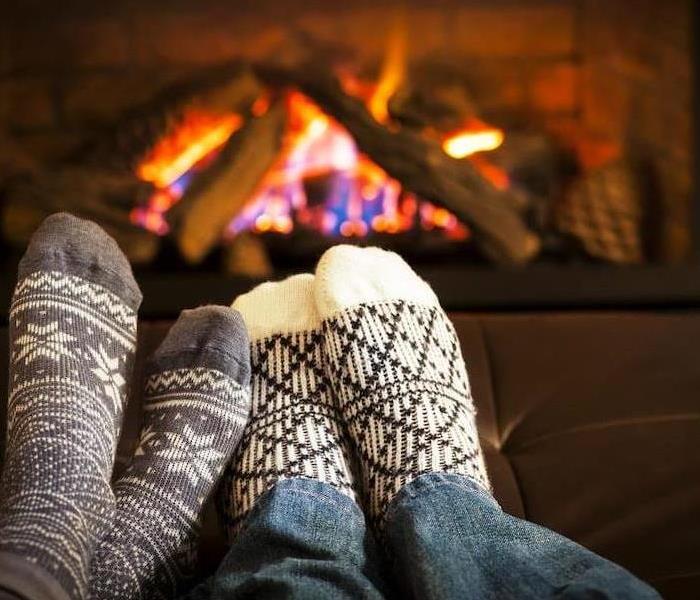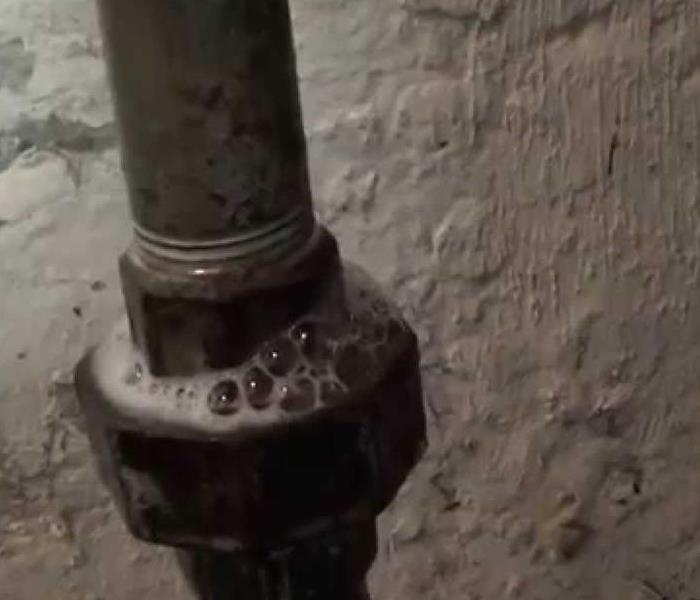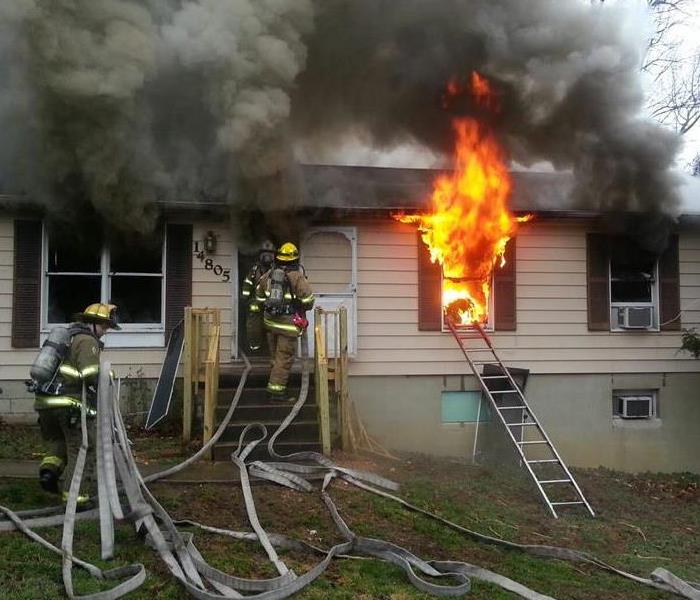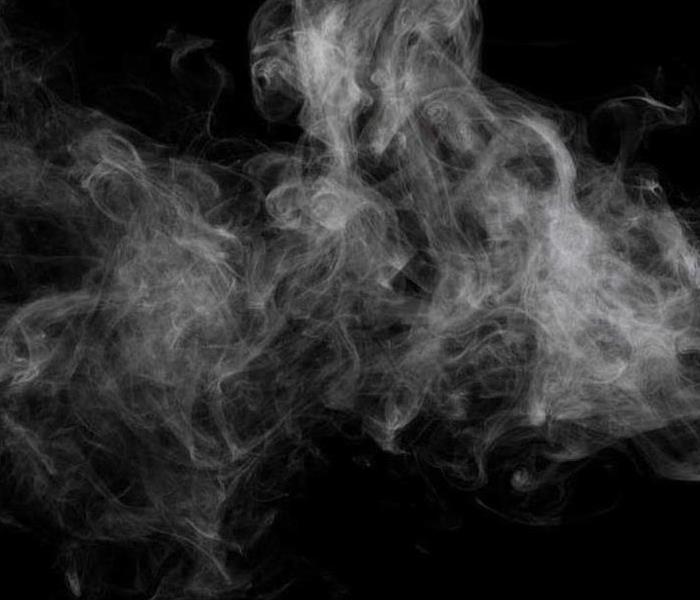Recent Fire Damage Posts
It's National Grilling Month!
7/1/2021 (Permalink)
July is National Grilling Month and, while we can’t wait to celebrate all month long, we thought we should highlight some key tips to make sure everyone is grilling safely.
- Make sure your grill is at least 10 feet away from your home- Charcoal and gas grills are designed to be used outdoors only. Don’t set up your grill under wooden overhangs or any tree branches.
- Clean your grill regularly- Remove any fat/grease from the grill and the tray below the grill. If you use a charcoal grill, make sure your coals are cooled off before disposing of them in a metal container.
- Check for gas leaks- Before the season’s first barbecue, check the gas tank hose for leaks by applying a light soap and water solution to the hose and then turning on the gas. If there is a propane leak, the solution will bubble. Other signs of a propane leak include the smell of gas near the barbecue or a flame that won’t light.
- Be safe around the grill- Make sure to keep an eye on any children or pets to assure they do not play close to the grill. Never try to move a hot grill. Never leave the grill unattended.
- Always have a fire extinguisher nearby- While having the extinguisher is important, you also have to know how to use it. If you do not know how to use it, call 911. Firefighters have stated that many fire deaths occur when people attempt to fight a fire by themselves instead of calling the station.
Remember these tips to stay safe this summer. SERVPRO of Norridge/Harwood Heights hopes you have a great summer!
A Cheatsheet to Firework Safety
7/1/2021 (Permalink)
One of the most popular activities during Fourth of July celebrations is watching or lighting fireworks. However, this activity can be highly dangerous.In 2017, eight people died and over 12,000 were injured badly enough to require medical treatment after fireworks-related incidents. In today’s blog, we’re providing firework safety tips to keep your family and you safe this holiday.
One of the best tips is to leave the fireworks to the professionals. They are properly trained and have experience using fireworks.
However, if you do decide to use legal fireworks, here are our tips to keep everyone safe:
- Never allow young children to handle fireworks
- Never use fireworks while under the influence of drugs or alcohol
- Never hold lighted fireworks in your hands
- Never light them indoors
- Do not try to re-light or handle malfunctioning fireworks
- Soak both spent and unused fireworks in water for a few hours before discarding
- Never use illegal fireworks
Additionally, according to the National Safety Council, fireworks start an average of 18,500 fires each year, including 1,300 structure fires, 300 vehicle fires and nearly 17,000 other fires. Here are some tips to protect your home while others use fireworks:
- Clean out your gutters- Gutters are often clogged with flammable items such as twigs or leaves. A stray spark from a firework could hit these items and start a fire. Remove any flammable items from your gutters and also dispose of them from your yard.
- Water your plants- If your plants are dry due to drought, it could be helpful to water them before lighting any fireworks. If they’re damp, they’re less likely to catch fire if they are hit by sparks from fireworks.
- Set off fireworks far from your house- The further away the firework display is, the better off you are in terms of avoiding damage to your home.
SERVPRO of Norridge wishes everyone a Happy Independence Day!
All About Red Flag Warnings
4/27/2021 (Permalink)
The National Weather Service issues many different alerts to keep people safe. While most people are familiar with alerts such as tornado warnings, severe thunderstorm warnings and high winds. One of the alerts that people are less familiar with is a Red Flag Warning.
What is a Red Flag Warning?
A Red Flag Warning is a forecast warning issued by the NWS that informs the public and firefighters that conditions are ideal for wildland fire combustion and rapid spread.
When are Red Flag Warnings issued?
They are issued when warm temperatures, low humidity, dry fuels and strong winds could combine to produce extreme fire behavior that is currently occurring or will occur in the next 24 hours.
What are some of the criteria to issue a Red Flag Warning?
- Sustained wind speeds averaging 15 MPH or greater
- Temperature over 75 ? or higher
- Relative humidity of 25% or less
Red Flag Warning Safety Tips
- Extinguish outdoor fires and never leave them unattended. Always drown fires with plenty of water.
- Soak any ashes or charcoal in water and dispose of them in a metal can.
- Remove any leaves, weeds, brush, firewood, and any other flammables such as gas cans, patio furniture, or lawnmowers from within 100 feet of your home.
- Do not throw cigarettes or matches from a moving car.
Winter Fire Safety
2/1/2021 (Permalink)
Winter in the Norridge/Harwood Heights area can be brutal. While we heat our houses to stay warm, we need to be careful and make sure we are being safe. Heating is the second leading cause of house fires after cooking. House fires due to heating peak in December, January and February. More than a quarter of home heating fires occur because the heat source was too close to things that are flammable. Space heaters are the type of equipment most often involved in home heating equipment fires, accounting for 44% of fires according to the National Fire Protection Association.
Some quick tips that can help prevent home fires:
- Keep anything flammable at least 3 feet away from heaters
- Never use your oven to heat your home
- Test smoke alarms once a month
- Turn portable heaters off when leaving the room or when going to bed
5 Appliances that Can Cause House Fires
8/25/2020 (Permalink)
A few weeks ago, we featured a blog post about different household appliances that can cause water damage or floods in your home. Today, I would like to continue the conversation, but this time focusing on different appliances that can cause house fires in your home. While appliances are completely safe, it is possible for a fire to occur.
Cooking Ranges
Human error can account for the majority of stove/oven fires, but it is possible to have an electrical error that causes a fire. Electric stoves actually cause more fires than gas stoves. It's important to keep a watchful eye on anything that you are cooking. Also, do not store anything on your stove.
Dryers
Dryers are the cause of 16,000 fires each year. Most of the fires are related to the lint trap not being cleaned. There can also be electrical issues which can cause a fire. Do not overload your dryer and follow the manufacturer’s instructions.
Dishwashers
Dishwashers are actually the second kitchen appliance that cause the most fires. The combination of water and electricity can cause electrical fires. We recommend not running your dishwasher when you are leaving your home.
Portable cookers
Slow cookers and chafing dishes are a common cause of house fires. Newer models of these items have timers, but older models do not. If you use an older slow cooker, make sure you aren’t using it overnight or while you are away.
Refrigerators
This appliance causes a lot more fires than expected. With refrigerators, the cause of the fire is never human error related, but instead electrical. Refrigerators are running all day and all night, and overtime, individual parts of the refrigerator can wear down, including compressors and relay switches, which are the primary causes of refrigerators igniting.
Bonfire Safety!
8/8/2020 (Permalink)
One of my favorite summer activities involves sitting around the fire with my family and enjoying roasted marshmallows. While having these fires can be relaxing and fun, we should also be aware of some safety tips regarding bonfires to make sure while we’re having fun, we are also being safe.
- Check the weather forecast. Make sure there aren’t any high winds, which could help the fire spread outside of a firepit.
- Wear appropriate clothing. Make sure your clothes are not flammable and wear hard-soled shoes, not rubber soles or flip flops.
- Keep a bucket of water or a garden hose nearby in case of the fire does spread outside of the firepit.
- Keep a safe distance from the fire and don’t horse around close to the fire. Keep a watchful eye on any children or pets.
- Make sure to put the fire out completely when you are done.
Bonfires are a super fun summer activity, but make sure you’re being safe while enjoying the fire.
What Should Be Thrown Away After a Fire?
1/22/2020 (Permalink)
House fires happen more often than you think and can cause immense damage. After a fire, you may feel like you want to save as many things as you can to save money, but after a fire, certain things should be thrown away for your safety.
Burnt Clothing
After a house fire, you may discover certain articles of clothing have been burnt or been affected by the extinguishment process. If the article of clothing is completely burnt, it should be thrown away. With clothing that has been affected by the extinguishment process or was affected by smoke damage, you may choose to keep these items, but they should be properly cleaned before being worn again.
Cosmetics and Toiletries
These items have to be stored at a proper temperature and the heat of a fire can affect the items. It can actually separate the materials in the products, which can make things, like sunscreen, less effective. While some cosmetics and toiletries can be expensive, it would be more beneficial to repurchase products instead of using products affected by the fire.
Food items
It’s important to throw away most food after a fire. The high heat from the fire can activate bacteria in the food. Also, while extinguishing a fire, either water or chemicals from the fire extinguisher can contaminate the food, which makes it no longer safe for consumption.
Bedding
If bedding has been burnt or affected after using a fire extinguisher, it should be properly cleaned and if it is unable to be cleaned, it should be thrown away.
Medicine
Any medication that has soot, smoke discoloration or fire extinguisher dust should be thrown out. The chemicals that are found within these things should not be consumed.
Winter Fire Safety Tips
11/1/2019 (Permalink)
While winter doesn’t officially start until December 21st, you can already the chill in the air. Winter comes at you fast and hard in this area. Once you feel that chill, you want to relax by the fireplace and drink hot cocoa. You know about certain risks during winter, like frostbite and blizzards, but you should also prepare for winter by following these winter fire safety tips and thinking about other ways you could pose risks to your home and family during the winter.
- Clean your chimney- Before you go about drinking that hot cocoa and using your fireplace, clear any build-up in your chimney, especially if you use wood or pellets in your fireplace. This build-up can cause fires.
- Don’t leave your fire unattended. The desire to light the fireplace is high in the winter months, but don’t leave with the fireplace lit. Make sure to put out the fireplace being leaving the room or house.
- When using your fireplace, make sure it is covered with a screen or tempered glass- Without these barriers, sparks could fly out and catch nearby things on fire, which is why it is also important to keep flammable things away from the fireplace. Also, keep kids and pets at least three feet away.
- Beware of space heaters- In order to use space heaters properly, they need a lot of space cleared out from around them. If you truly need a space heater, consider getting one with an auto shutoff in case of excessive heat.
- Use candles carefully- I love a good candle in the winter, especially one with a holiday scent, but when using these candles, they shouldn’t be near anything they could light on fire. Nor should you leave the room before blowing them out. Also, watch kids and pets near them, as they could be very dangerous.
- Test your smoke alarms- Double check the batteries in your smoke alarms so they are always ready in case you need them. Make sure they are located in the kitchen, bedrooms and laundry rooms, as these rooms can be the most likely to be the start of a fire.
- Have your furnace professionally checked- It is better to use a professional than doing it yourself, because they are properly trained and can assure everything is running smoothly.
And lastly, if you are driving around and see smoke in the air that seems to be coming from a home, take a second look and make sure before you call an emergency service. In the beginning of the cold season, people use their furnaces and fireplaces for the first time and it can create a dark smoke, which can be perceived as smoke from a house fire. However, if you are truly doubting, call 911 to confirm.
SERVPRO of Norridge/Harwood Heights wishes you a safe and happy winter!
Fire Safety Tips for Pets
10/14/2019 (Permalink)
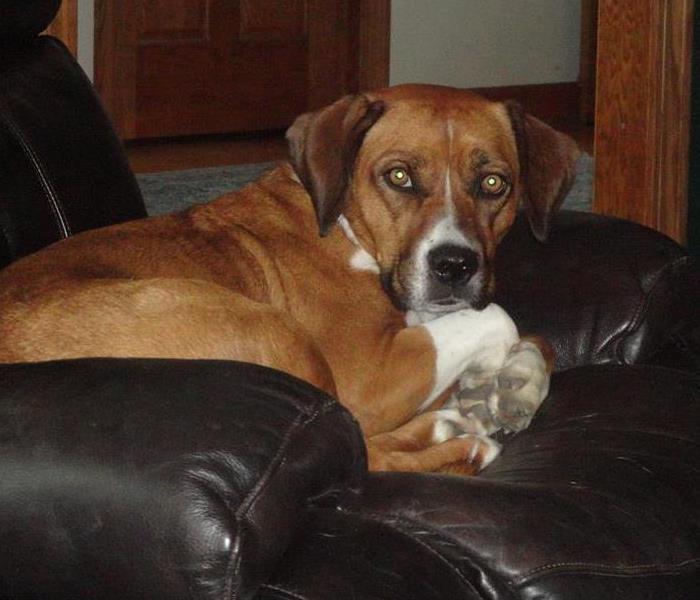 This is one of our dogs, Penny.
This is one of our dogs, Penny.
Our pets are very important to our family, because they are members of the family. While thinking of possible emergencies, it’s crucial to remember our pets in any contingency plans. While preparing for a possible house fire, there are ways to make it easier and faster to keep your pets and your family safe. Below are pet safety tips relating to a house fire:
- Know where your leashes are- In a fire, you need to get out of the house quickly, and the easiest way to do this with pets is to put them on their leash. We recommend keeping the leashes near the front door so they can be accessed quickly to make evacuation easier.
- Always keep collars on your pets (both dogs and cats)- If you have to evacuate without your pets for any reason, having a collar on your pets will make it easier for a firefighter to grab them to take them out of the house.
- Do not go back into your house to save your pets- Animals are much smarter than we give them credit for. They will see smoke and fire and know that it is a sign of danger. They will save themselves and leave the house. They are also much lower to the ground, which means they will inhale a lot less smoke and the temperature will be lower.
- Microchip your pets- If your pet has escaped by itself from your home, it can easily be located and identified with a microchip. Most vet offices can microchip your pets.
- Buy stickers to indicate that your home has pets- Most pet stores will sell these stickers that can be placed on or near your front door that will alert firefighters that you have pets in the home in case a fire breaks out when you are not home.
SERVPRO of Norridge/Harwood Heights knows how important pets are and wants to make sure that pets are safe from the possibility of fire. Please follow these tips above and use best judgment.
Avoiding a Dangerous Gas Leak
9/24/2019 (Permalink)
While watching the nightly news, it’s not uncommon to see a story about a house exploding due to a natural gas leak. It happens all too often and is absolutely terrifying. All of your belongings could be gone in seconds. It only takes a spark to explode your home after a gas leak. Below are signs of a gas leak and how to prevent a gas leak.
Know The Signs of a Gas Leak
Natural gas is naturally odorless, but they add another chemical to it to make it have a smell, so they can make it more detectable. The smell is usually similar to rotten eggs, so this can be a first sign of a gas leak. You may also notice bubbles in any standing water, thus showing a leak of natural gas into these locations. Also, check around the pipeline for any dying vegetation, because that is also a sign that there is a natural gas leak. You may also hear a hissing or roaring sound near the pipeline. The most common leak is actually carbon monoxide. To protect yourself against this, install a carbon monoxide detector in your home. The most important spaces to have these detectors in is any utility rooms or near where any furnaces or water heaters are kept.
Addressing the Leak
If you have noticed any of the above things and you assume you have a leak, don’t use any appliances in your home. Also, don’t smoke anything or use open flames, as this could cause an explosion. Don’t attempt to locate where the leak could be coming from, but instead, leave your home and call 911 and a utility company immediately.
Tips to Avoid a Gas Leak
Never use a gas stove to heat up your home. It may seem like a smart move, but the carbon monoxide from the stove will build up. Effectively, you’re just leaking your own gas now, which can escalate to be very dangerous. Make sure to clear out areas near any natural gas appliances or fireplaces. This is to avoid these things easily catching fire. Lastly, know where your gas shut off is located. If you notice a gas leak, shut off your gas immediately. This way, no more gas can be leaked.
Another important tip is to have regular inspections of your gas lines and your gas connections to your appliances. It is recommended to have these inspections once a year. This way, a problem can be noticed before it can cause any damage.Also, a very important tip is to call before you dig! If you dig and hit a gas line, it can begin to leak and be very dangerous for you and your neighborhood. Instead, call and make sure there are no gas lines where you will be digging.
SERVPRO of Norridge/Harwood Heights is proud to bring you these tips to keep your family and your home safe from any gas leaks that can cause dangerous explosions.
Causes of House Fires
7/8/2019 (Permalink)
House fires can happen for a variety of reasons. There are super common reasons for house fires which can include cooking equipment, heating (like portable heaters), smoking, and candles. These are things that we know to use caution or avoid when thinking about how to prevent house fires.
With cooking equipment:
- don't leave food unattended while cooking
- make sure to cook at the proper temperature
- clean stove before cooking
With candles:
- make sure that your candle holder is stable
With heating:
- don't place space heaters near flammable items
Some lesser known reasons for a house fire can be dust, which can gather near electrical sockets or space heaters. With one spark, the dust can ignite. Laptops can cause fires as well if they are left on a couch or a bed, because they cannot properly be vented.
There are quite a few different reasons that house fires can occur. SERVPRO of Norridge/Harwood Heights wants you to think about ALL causes of house fires and correct anything in your home that could cause fires.
All About Smoke and Soot Following a Fire
6/15/2019 (Permalink)
Experiencing a fire in your home or business can be very scary and stressful. While some damage can be seen, there is other damage that cannot. Smoke and soot is very invasive and can penetrate various cavities within your home, causing hidden damage and odor. Our smoke damage expertise and experience allows us to inspect and accurately assess the extent of the damage to develop a comprehensive plan of action.
Smoke and soot facts:
- Hot smoke migrates to cooler areas and upper levels of a structure.
- Smoke flows around plumbing systems and actually seeps through the holes used by pipes to go from floor to floor.
- The type of smoke may greatly affect the restoration process.
Different Types of Smoke
There are two different types of smoke–wet and dry. As a result, there are different types of soot residue after a fire. Before restoration begins, SERVPRO of Norridge/Harwood Heights will test the soot to determine which type of smoke damage occurred. The cleaning procedures will then be based on the information identified during pretesting. Here is some additional information:
Wet Smoke – Plastic and Rubber
- Low heat, smoldering, pungent odor, sticky, smeary. Smoke webs are more difficult to clean.
Dry Smoke – Paper and Wood
- Fast burning, high temperatures, heat rises therefore smoke rises.
Protein Fire Residue – Produced by evaporation of material rather than from a fire
- Virtually invisible, discolors paints and varnishes, extreme pungent odor.
Our Fire Damage Restoration Services
Since each smoke and fire damage situation is a little different, each one requires a unique solution tailored for the specific conditions. We have the equipment, expertise, and experience to restore your fire and smoke damage. We will also treat your family with empathy and respect and your property with care. We want to make sure its "Like it never even happened."
All About Smoke Alarms
6/3/2019 (Permalink)
 Smoke Alarms cut the risk of dying from home fires in half.
Smoke Alarms cut the risk of dying from home fires in half.
The best thing you can do to help yourself during a fire, is to be prepared beforehand. Smoke alarms can alert you to a fire fast in order to get your family out safe and so you can call emergency services to limit damage. Below are tips pertaining to smoke alarms as provided by National Fire Protection Association.
- A closed door may slow the spread of smoke, heat and fire. Install smoke alarms in every sleeping room and outside each separate sleeping area. Install alarms on every level of the home. Install alarms in the basement. Smoke alarms should be interconnected. When one sounds, they all sound.
- Large homes may need extra smoke alarms.
- It is best to use interconnected smoke alarms. When one smoke alarm sounds they all sound.
- Test all smoke alarms at least once a month. Press the test button to be sure the alarm is working.
- Today’s smoke alarms will be more technologically advanced to respond to a multitude of fire conditions, yet mitigate false alarms.
- A smoke alarm should be on the ceiling or high on a wall. Keep smoke alarms away from the kitchen to reduce false alarms. They should be at least 10 feet (3 meters) from the stove.
- People who are hard-of-hearing or deaf can use special alarms. These alarms have strobe lights and bed shakers.
- Replace all smoke alarms when they are 10 years old.
- Smoke alarms are an important part of a home fire escape plan.
Remember If a fire occurs in your home, GET OUT, STAY OUT and CALL FOR HELP. Never go back inside for anything or anyone.
SERVPRO of Norridge/Harwood Heights reminds you to check your smoke alarms and stay safe in case of a fire!
What to do During and After a Fire
5/9/2019 (Permalink)
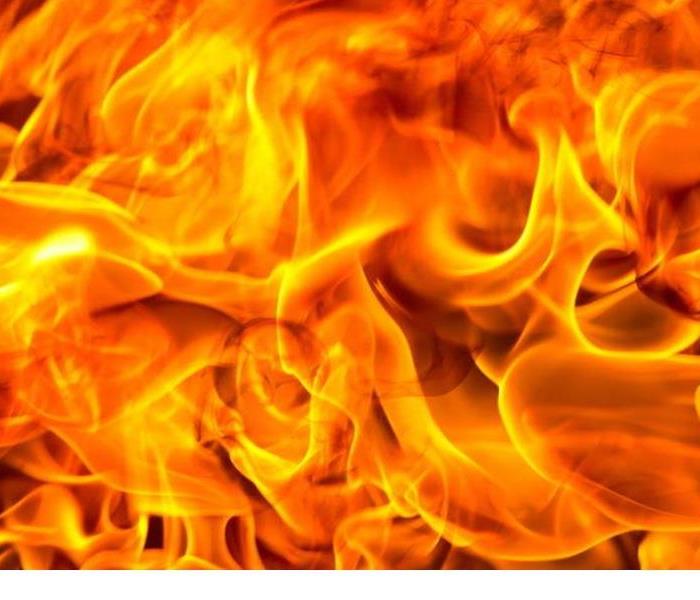 In just 5 minutes, a residence can be engulfed in flames.
In just 5 minutes, a residence can be engulfed in flames.
While thinking about the event of a fire at your house could be scary and stressful, it's important to know what to do during and after a fire to keep your family and you safe and be prepared in what you can do to help your house after the fire. Its also important to prepare yourself and your family in case your residence should ever catch fire.
BEFORE
- The best thing you can do to prepare for a fire is discuss a meeting place among the family. In case of a fire, the family can reunite at this safe place. This lets you know the members of your family are safe and no longer in the building.
- Check smoke alarms every month and replace the entire alarm every 10 years
DURING
- React immediately after hearing the fire alarm
- Safely exit through doors by checking for incoming smoke or feeling the door for any heat
- Protect yourself from smoke inhalation by keeping low to the ground
- Once safely outside, call 911
AFTER
- After the fire is put out, do not enter your house in case of structure damage
- Once cleared, limit movement inside the house to avoid soot particles being embedded into your carpet or upholstery
- Empty your refrigerator and freezer and leave the doors open if your electricity is off to avoid spoilage
- Call SERVPRO of Norridge/Harwood Heights to help with clean up.
SERVPRO of Norridge/Harwood Heights is always ready to help after a fire and we will make it look "Like it never even happened."
Help people decide when to use a fire extinguisher
4/18/2018 (Permalink)
Fire extinguishers can be helpful on a small fire. Consider providing a checklist to help people prepare to use a fire extinguisher on a potential fire.
For example:
- Have I alerted others in the building that there’s a fire?
- Has someone called the fire department?
- Am I physically able to use a fire extinguisher?
- Is the fire small and contained in a single object (like a pan or a wastebasket)?
- Am I safe from the fire’s toxic smoke?
- Do I have a clear escape route?
Use a fire extinguisher when all of these questions are answered “yes.” If you’re unsure about whether or not it’s safe to use a fire extinguisher, and for all other situations, alert others, leave the building, and call 911 from a mobile or neighbor’s phone. It is not recommended that children use fire extinguishers.
Fire Escape Plan
4/17/2018 (Permalink)
Tips for a fire escape plan from SERVPRO of Norridge/Harwood Hts.
- Draw a map of your home with all members of your household, marking two exits from each room and a path to the outside from each exit.
- Practice your home fire drill twice a year. Conduct one at night and one during the day with everyone in your home, and practice using different ways out.
- Teach children how to escape on their own in case you can’t help them.
- Make sure the number of your home is clearly marked and easy for the fire department to find.
- Close doors behind you as you leave – this may slow the spread of smoke, heat, and fire.
- Once you get outside, stay outside. Never go back inside a burning building.
Be prepared for all disasters.
2/13/2018 (Permalink)
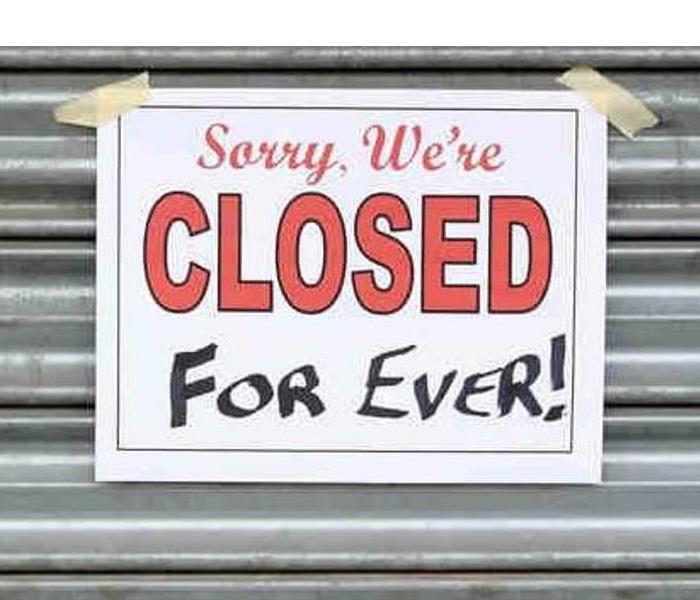 Closed business
Closed business
SERVPRO of Norridge/Harwood Heights will do ERP(Emergency Ready Profile Plan) for your company free. Be ready for all disasters.
Over 75% of companies that experience a serious fire go out of business, either directly as a result of the fire or within 3 years of reopening.The damage that a fire can cause to a business cannot be over estimated. The visible signs of a burnt out building and ruined inventory is only half the story. There is also the consequential losses from business interruption, laying off employees and the customers who are forced to turn to alternative suppliers and never return. Insurance may help to soften the blow but most businesses do not recover.
Fire sprinkler systems are the most effective means of fire protection. It is essential that they are inspected so they remain in good working condition. Fire sprinkler systems may sit for several years without being called upon, but when a fire breaks out, they must work effectively.
If you do have a fire let SERVPRO of Norridge/Harwood Hts. get you back in business fast.
Dangers of Fire
2/13/2018 (Permalink)
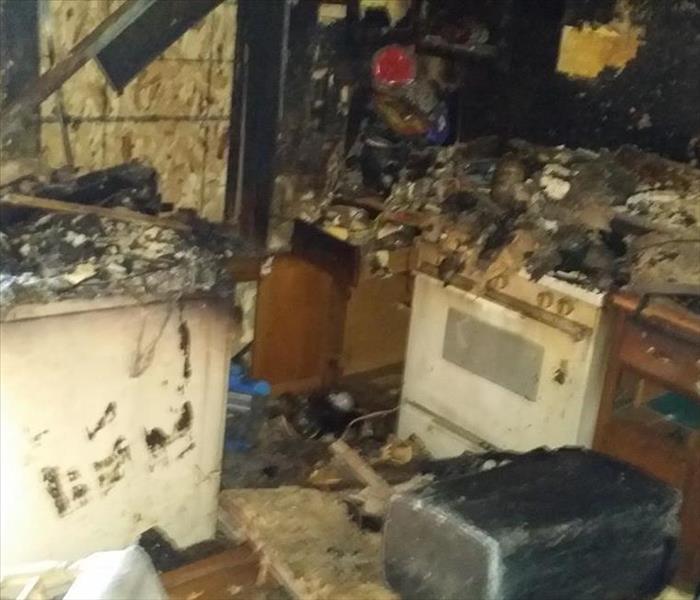 Apartment Fire
Apartment Fire
Fire spreads Fast!
When a fire occurs, there is little time to escape. A fire can spread by doubling its size in seconds. In less then 30 seconds, a fire can rage out of control, filling the area with heat and toxic thick smoke. Remember, when a fire is discovered, you need to get out quick.
- Fire is Dark!
The thick black smoke that is given off from a fire can make it blinding to see where you are going. It will be extremely difficult to see. By crawling low, it may help you to see a little better, as well as; breathe some of the cooler air. It is important to remember, if the smoke is too thick in the hallway to escape, you may need to shelter-in-place and find another way out perhaps through a window or another exit. You should always plan for at least two ways out. By closing a door(s), it can help reduce the spread of smoke and fire.
- Fire is Deadly!
Most people who die in fires die from the toxic gases, thick black smoke, and lack of oxygen. In a fire, breathing even small amounts of these toxic elements can disorient someone, causing them to pass out. Remember smoke detectors save lives. The time to react to a fire/ smoke alarm is when it first goes off. Never ignore an alarm!
All Important Smoke Alarm
2/13/2018 (Permalink)
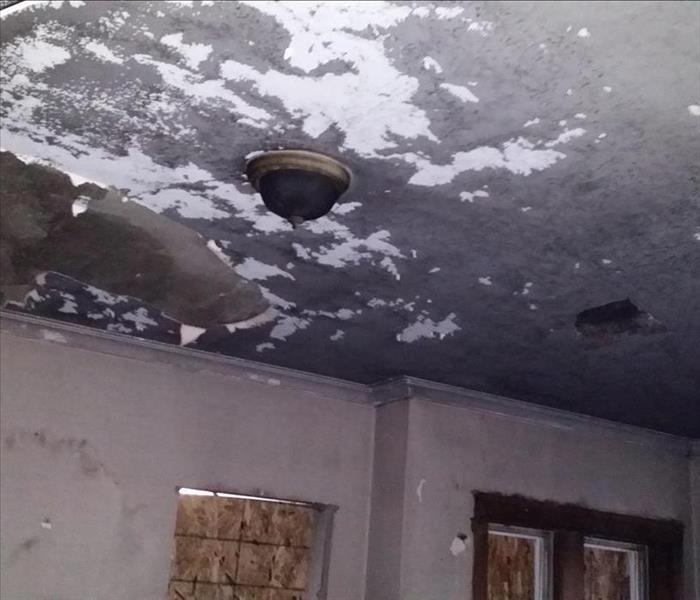 Smoke Detectors Save Live. Don't let this happen to you.
Smoke Detectors Save Live. Don't let this happen to you.
SERVPRO of Norridge/Harwood Hts. brings you tips from the Red Cross
Smoke alarms double the chance of your family surviving a fire, so it goes without saying that you should have several.
- Don’t neglect to test them and change the batteries regularly.
- You should test them once a month and change the batteries every 6 months (if your smoke alarms use replaceable batteries) regardless of whether they seem to need it, just to be on the safe side (some alarms are 10-year tamper resistant and don’t have replaceable batteries).
- You know the drill — make it a habit to change batteries twice a year when you turn your clocks.
Remember If a fire occurs in your home, GET OUT, STAY OUT and CALL FOR HELP. Never go back inside for anything or anyone.
Space Heaters
2/13/2018 (Permalink)
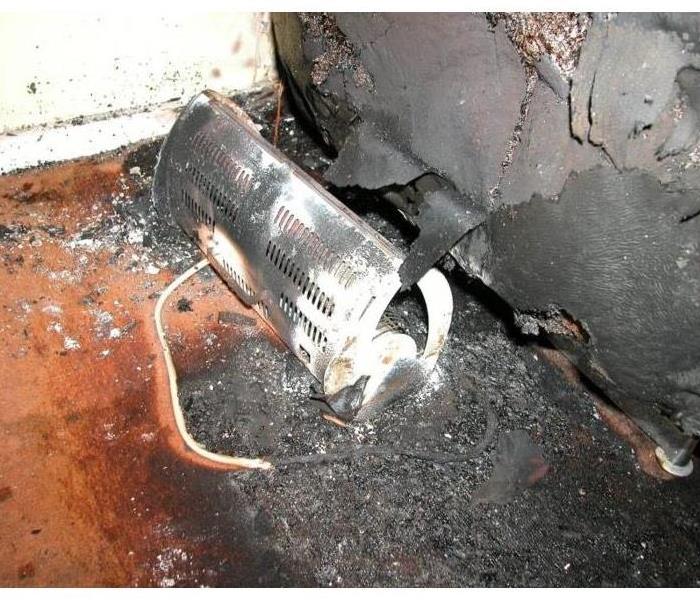 Space Heaters need Space
Space Heaters need Space
Facts & figures
Based on 2011-2015 annual averages:
- Space heaters, whether portable or stationary, accounted for just over two of every five (43%) of home heating fires and four out of five (85%) of home heating fire deaths.
- The leading factor contributing to home heating fires (28%) was failure to clean, principally creosote from solid-fueled heating equipment, primarily chimneys.
- Placing things that can burn too close to heating equipment or placing heating equipment too close to things that can burn, such as upholstered furniture, clothing, mattress, or bedding, was the third leading factor contributing to ignition in fatal home heating fires and accounted for more than half (53%) of home heating fire deaths.
- Nearly half (48%) of all home heating fires occurred in December, January and February.
Red Cross Fire Safety Tips
12/5/2017 (Permalink)
Install the right number of smoke alarms. Test them once a month and replace the batteries at least once a year.
Teach children what smoke alarms sound like and what to do when they hear one.
Ensure that all household members know two ways to escape from every room of your home and know the family meeting spot outside of your home.
Establish a family emergency communications plan and ensure that all household members know who to contact if they cannot find one another.
Practice escaping from your home at least twice a year. Press the smoke alarm test button or yell “Fire“ to alert everyone that they must get out.
Make sure everyone knows how to call 9-1-1.
Teach household members to STOP, DROP and ROLL if their clothes should catch on fire.
- Keep items that can catch on fire at least three feet away from anything that gets hot, such as space heaters.
- Smoking materials are the leading cause of residential fire deaths in the United States. If you smoke, take precautions: Smoke outside; choose fire-safe cigarettes; never smoke in bed, when drowsy or medicated, or if anyone in the home is using oxygen.
- Use deep, sturdy ashtrays and douse cigarette and cigar butts with water before disposal.
- Talk to children regularly about the dangers of fire, matches and lighters and keep them out of reach.
- Turn portable heaters off when you leave the room or go to sleep.
- Never leave a burning candle unattended, even for a minute.
Norridge Harwood Heights or northwest Chicago Smoke and Soot Cleanup
12/9/2016 (Permalink)
Smoke and soot is very invasive and can penetrate various cavities within your home, causing hidden damage and odor. Our smoke damage expertise and experience allows us to inspect and accurately assess the extent of the damage to develop a comprehensive plan of action.
Smoke and soot facts:
- Hot smoke migrates to cooler areas and upper levels of a structure.
- Smoke flows around plumbing systems, seeping through the holes used by pipes to go from floor to floor.
- The type of smoke may greatly affect the restoration process.
Different Types of Smoke
There are two different types of smoke–wet and dry. As a result, there are different types of soot residue after a fire. Before restoration begins, SERVPRO of Norridge/Harwood Heights will test the soot to determine which type of smoke damage occurred. The cleaning procedures will then be based on the information identified during pretesting. Here is some additional information:
Wet Smoke – Plastic and Rubber
- Low heat, smoldering, pungent odor, sticky, smeary. Smoke webs are more difficult to clean.
Dry Smoke – Paper and Wood
- Fast burning, high temperatures, heat rises therefore smoke rises.
Protein Fire Residue – Produced by evaporation of material rather than from a fire
- Virtually invisible, discolors paints and varnishes, extreme pungent odor.
Our Fire Damage Restoration Services
Since each smoke and fire damage situation is a little different, each one requires a unique solution tailored for the specific conditions. We have the equipment, expertise, and experience to restore your fire and smoke damage. We will also treat your family with empathy and respect and your property with care.





 24/7 Emergency Service
24/7 Emergency Service

